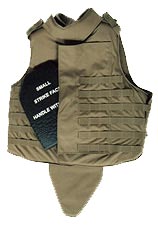One new product is Teijin’s Laminated Fabric Technology, or LFT, a fabric woven from Twaron fibers with a large number of densely packed, very fine-denier fibers which, according to the manufacturer, are improving protection level, compared to thicker, coarser fabric made of the same composite materials. Teijin, the manufacturer of Twaron, developed a lightweight laminated fabric taking advantage of the fiber’s patented Microfilament yarns.
These microyarns are woven in such a way that crossover of warp and fill are minimized, and the woven fabric is subsequently formed into a sandwich, using extremely thin thermoplastic film, yielding lighter weight armor in a process, the company calls “complicated.” The LFT design rapidly dissipates energy when impacted by a bullet or fragment. LFT, initially introduced for soft body armor applications, will be used in a family of antiballistic products for many applications, including military and commercial vehicles.
Inserts made of lightweight High-Density Polyethylene (HD-PE known as Dyneema) can offer ballistic protection of steel plate at 45% of the weight. Through the production process HD-PE is processed through pressure and heat treatment, followed by the application of surface coating sealing it from the degrading effect of solvents, fuels and water. In contrast to ceramic tiles, HD-PE can be shaped into complex designs that best fit the human anatomy, therefore enhancing protection provided to all vital organs offering high multi-hit protection.
Another option for reinforcement of composite fibers is by utilizing ballistic steel fibers, produced by Hardwire, which demonstrated good ballistic properties at weight significantly lower than steel plates and at a lower cost than most advanced fibers.
Ceramics produced from ultra-fine grains known as nano-particles introduce enhanced capabilities. Such nano-based ceramics have the potential to introduce advanced composites with stopping power and durability unmatched by current armor protection suits. An Israeli company ApNano materials has recently tested one of the most shock-resistant materials known to man based on a metallic-based nano-material called IF nanospheres. The material is five times stronger than steel and at least twice as strong as any impact-resistant material currently in use as protective gear.
Attempting to balance between weight, protection and comfort, researchers are studying super-strong fibers based on advanced fibers such as DuPonts’ new M5, carbon nano-tubes, and Kevlar, impregnated with nanomaterials suspended in Sheer Thickening Fluids (STF), improving the flexibility of soft armor, and ballistic and stab protection of standard uniform.
In this series Defense Update covers the following topics:
- Body Armor Suites
- Ergonomic Body Armor Designs
- Ballistic Helmets
- Physiological and Physical Challenge of Body Armor
- Eyewear Protection for the Warfighter
- Tactical Benefits of Laser Eye Surgery (LASIK / PRK)
- Cooling with Phase Change Materials (PCM)
- Improving the Combat Survival Rate Among the Wounded
- Load Carrying Systems for the Infantry
















